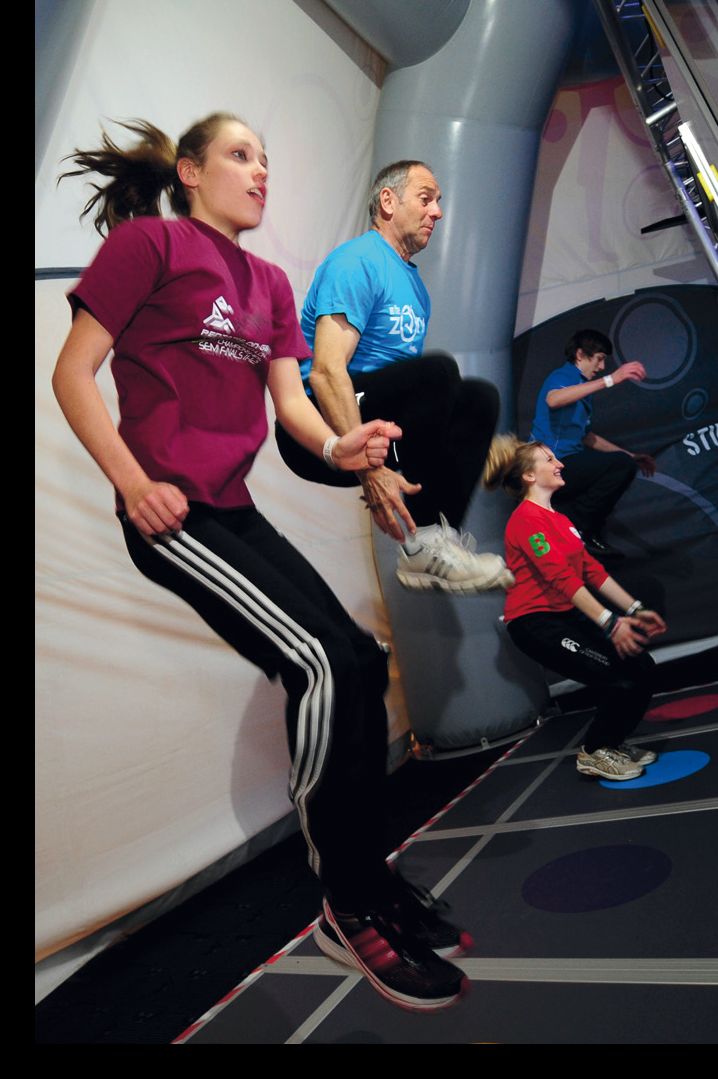
Physiology News Magazine
A year ‘In the Zone’: a physiology roadshow from commission to completion
News and Views
A year ‘In the Zone’: a physiology roadshow from commission to completion
News and Views
Sarah Hall
Cardiff University, UK
https://doi.org/10.36866/pn.89.10
How many physiologists does it take to make an interactive touring exhibition about the physiology of exercise? The answer is – not many! From recent experience, I’ve learned that the physiologists are just a small component of a much bigger team, which includes engineers, computer technicians, designers, marketing and publicity experts, educators, tent manufacturers and even theme-park organisers.
Over the past year, I have been involved in a Wellcome Trust-funded initiative to develop an interactive physiology exhibition called ‘In the Zone’. The science centre At-Bristol was chosen to create an exhibition building on the excitement surrounding the London 2012 Olympic Games to explain aspects of exercise physiology to the general public. The aim was to produce an outdoor touring exhibition that would travel to all 12 regions of the UK during the summer of 2012, to reach people who might not usually engage with science. Despite the very short time scale of the project and the wettest summer. since records began, all evidence suggests that, in the end, the exhibition was a great success.
November 2011: I was invited to be part of a small panel advising on the content of the exhibition. Our early brainstorming activities were inspired by Olympic sports and focused on topics that were scientifically intriguing and had some practical activity that could be measured easily and robustly. Discussions took place in the workshops of At-Bristol where we had great fun playing with prototype exhibits and generating ideas on how to demonstrate aspects of exercise physiology in novel and exciting ways. We winced at our vertical jumps replayed in slow-motion as we considered aspects of muscle contraction and force development, we calculated the calorific value of a single peanut as we generated power using hand cranks and we laughed at the colour of our cold hands on thermal camera images as we discussed changes in peripheral blood flow. At this early stage, though, lots of our ideas fell by the wayside because of financial or technical constraints. Even feasible ideas had to be modified to account for restrictions on time and space.
December 2011: As the scientific content of the exhibition developed, other groups were advancing key practical and technical aspects of this unique exhibition. The size, shape and even the colour of the structure to house the exhibition was considered at length, before a brightly decorated dome-shaped tent was chosen. The fluid movement of people through the exhibition was calculated by drawing on expertise from theme parks. Novel software was developed to allow participants to access their own data and video from the exhibits via a unique barcode system. This personal information could then be shared with family and friends. As Christmas came and went, exhibition testing began and the exhibition began to take shape.
January 2012: By the New Year, designers were developing the overall look and theme of the exhibition. The final concept of a studio broadcasting sports-related programmes meant that participants would feel part of a live TV show and this theme would run through all the aspects of the exhibition. At the same time a range of potential sites around the UK were investigated, so that the exhibition could be taken to a broad geographical and socio-economic profile of the population. All of this took place even before anyone faced the practicalities of making sure the whole exhibition fitted into an articulated lorry, so that it could be transported between venues and reassembled without losing any essential components or too much sleep.


February 2012: Insulated from such logistical concerns, the scientific advisory group continued to help develop the content of the exhibition, moving from the interactive components of the exhibits to generating and approving the information in the transition zones and the wall panels. ‘Showbiz Sean’, the designer, flew direct from New York fashion week to work with us on the script for the commentary. A high-energy stage show was developed, involving audience participation and demonstrations, to entice visitors and entertain waiting crowds. Actors were auditioned to take the part of TV presenters on stage and At-Bristol staff volunteered enthusiastically to travel round the UK keeping the show on the road – little did they realise they would be working 10 hour days and sleeping in the ‘In the Zone’ camper van every night.
March 2012: With the Big Bang Fair approaching, aspects of the exhibition and stage show were showcased at a press event at At-Bristol. Together with elite athletes from Cardiff University and Bristol schools, we ‘road-tested’ the exhibits and competed eagerly with ‘In the Zone’ project champion Sir Steve Redgrave and Paralympic bronze medallist Ben Rushgrove to run faster, jump higher and react quicker. While the athletes were already well tuned to their own physical abilities, of course, they were fascinated to discover more about the physiological factors influencing their performance. Sir Steve demonstrated he still has an impressive lung capacity of 7.5 litres, which put the rest of us to shame.
April 2012: Tight control of the movement of visitors through the zones of the exhibition was essential to meet the high audience targets set by the Wellcome Trust. This required clever choreography, as well as robust mechanical and electrical equipment and heavy editing of content. It was no mean feat to create an exhibit that allowed people to view the veins in their hands and record their ECG, while considering the role of the circulation – all in under 120 seconds. At this stage, the main job of the advisory panel was to make sure that scientific integrity remained intact as the exhibition was fine tuned. Fortunately, the exhibition website offered participants the opportunity to get extra information after their visit, as well as the chance to compare their data with that of athletes and others members of the public, and to re-live their experience via a personalised showreel.
May–August 2012: During the wettest summer on record, the exhibition literally pitched its tent all around the UK at music festivals, county fairs and air shows; it even formed part of the Blue Peter roadshow, before settling in London’s Victoria Park for the duration of the Olympic Games. The team worked tirelessly to make sure that the exhibits kept working and the event continued to excite and educate visitors of all ages and from all parts of the UK. Over 91,000 people had an ‘In the Zone’ experience and learnt about the physiology of their body systems. Despite relentless rain, treacherous mud and only rare glimpses of sunshine, feedback from these visitors indicated that they had really enjoyed the whole experience and had learned something new. Some eager visitors waited in line to go through the exhibition twice and one little boy must have spent his entire summer holiday ‘In the Zone’, as he managed over 20 trips through the tent – a budding physiologist of the future, perhaps?
exhibition.getinthezone.org.uk
The five zones of the exhibition:
Power: Perform a standing jump and learn about muscles and joints
Blood: Monitor your heart, look at your veins and learn about O2 delivery to and CO2 removal from working tissues
Exercise: Power a hand crank and learn how much work your muscles perform
Reaction: Test your reaction time and learn about nerve conduction
Sprint: Race 10 m and learn how all the body systems work together to move your body
